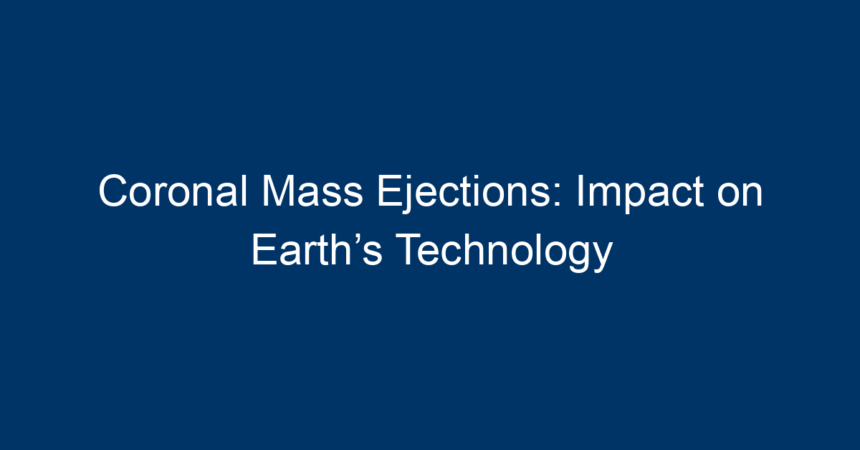In an increasingly technology-dependent world, the interactions between space weather phenomena and our technological systems are becoming a pressing concern. One of the most significant phenomena in this realm is coronal mass ejections (CMEs). Understanding these massive bursts of solar wind and magnetic fields can help us mitigate their adverse effects on Earth’s technology and infrastructure. In this article, we will delve into what coronal mass ejections are, their potential impacts on our technology, and what we can do to prepare for them.
What Are Coronal Mass Ejections?
Coronal mass ejections are large expulsions of plasma and magnetic fields from the solar corona. These powerful bursts can release billions of tons of solar material, traveling at speeds of up to several million miles per hour. They occur approximately 1-3 times a week during periods of heightened solar activity, such as solar flares and solar cycles.
The sun’s activity follows an approximately 11-year solar cycle, during which periods of high activity correlate with an increased likelihood of CMEs. When these charged particles reach Earth, they can interact with the planet’s magnetic field, leading to a variety of phenomena, including geomagnetic storms.
Understanding the Mechanism
The process of a coronal mass ejection typically begins with the destabilization of solar magnetic fields. When these magnetic fields stretch and twist due to the sun’s dynamic surface, they can suddenly release massive amounts of energy and solar material. This ejected mass then travels through space and can impact Earth’s magnetosphere.
The Impact of Coronal Mass Ejections on Technological Systems
While coronal mass ejections can create stunning auroras and other natural phenomena, their potential to disrupt Earth’s technological systems is concerning. Here are some of the primary ways CMEs can affect modern technology:
1. Disruption of Power Grids
One of the most significant impacts of coronal mass ejections is on electrical power grids. A CME can induce geomagnetic currents, which may affect transformers and other components of the electricity supply system. In severe cases, these disruptions can lead to widespread blackouts, as witnessed in the 1989 Quebec blackout, which was caused by a CME.
2. Satellite Damage
Satellites, critical for communication, navigation, and weather forecasting, can also be severely affected by CMEs. The energetic particles and radiation can damage satellite electronics and sensors. This may lead to malfunctioning systems or reduced communication capabilities. Monitoring and predicting CMEs can help satellite operators mitigate these risks.
3. Interference with Communication Systems
Both terrestrial and satellite communication systems can experience disruptions due to CMEs. High-frequency radio waves are particularly vulnerable to the effects of geomagnetic storms caused by coronal mass ejections. Airlines and maritime operations that rely heavily on precise communication can be adversely affected, leading to potential safety concerns.
4. Impact on GPS Systems
Global Positioning System (GPS) technology can also be compromised during the intensified conditions following a CME. Disturbances in the ionosphere, which affect satellite signals, can lead to inaccuracies in location tracking. This is especially concerning for military operations and autonomous navigation systems.
5. Aviation Hazards
Commercial and military aircraft are at risk during strong CMEs. Increased levels of radiation pose a health risk to passengers and crew members, particularly during high-altitude flights near the polar regions. Airlines closely monitor solar activity to reroute flights and enhance passenger safety.
Preparing for Coronal Mass Ejections
Understanding the risks posed by coronal mass ejections is vital, but preparation is equally important. Here are some actionable steps for individuals, businesses, and governments to minimize the potential impacts:
1. Enhanced Monitoring Systems
Governments and space organizations should invest in robust monitoring systems to detect CMEs early. Instruments like NASA’s Solar and Heliospheric Observatory (SOHO) and the Solar Dynamics Observatory (SDO) provide crucial data. By improving our ability to predict when a CME might occur, we can take proactive measures to protect our technology.
2. Infrastructure Hardening
Power companies can strengthen their infrastructure to withstand geomagnetic storms. This includes installing advanced monitoring equipment and designing transformers that can handle induced currents. Effective grid management practices can also help manage risks during geomagnetic storms.
3. Employee Training
Organizations reliant on technology should educate employees about the risks associated with CMEs. Ensuring that teams are prepared to respond to potential disruptions can help mitigate risks and minimize downtime. Regular drills and educational programs can promote awareness and readiness.
4. Public Awareness Campaigns
Raising public awareness about the potential impacts of coronal mass ejections can foster a sense of preparedness. Community workshops, informational websites, and social media outreach can educate the public on how to protect personal technology during solar events.
5. Disaster Recovery Plans
Businesses should include CMEs in their disaster recovery and business continuity plans. Understanding the potential impact of solar events on operations allows companies to develop effective response strategies. This proactive approach can save time and resources during unexpected disruptions.
Conclusion
Coronal mass ejections represent a formidable force in the interplay between solar activity and technological systems on Earth. As we continue to innovate and rely on technology across various sectors, understanding and preparing for the effects of CMEs is critical. By investing in advanced monitoring systems, reinforcing infrastructure, and promoting public awareness, we can mitigate the risks associated with these powerful solar events.
As individuals and organizations, we must stay informed and take actionable steps to ensure that we are prepared for potential disruptions caused by coronal mass ejections. By doing so, we can navigate the challenges posed by space weather and continue to thrive in an increasingly connected world.




